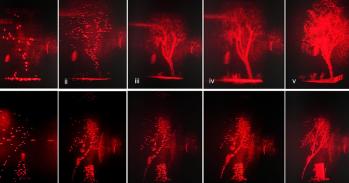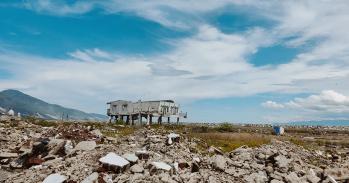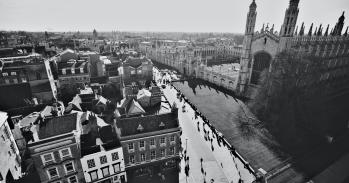
Working with humanitarian organisations in Haiti, Cambridge researchers have found that an information system they designed to track how regions recovered from disasters can also be used to support preparedness, planning and project management.
Working with humanitarian organisations in Haiti, Cambridge researchers have found that an information system they designed to track how regions recovered from disasters can also be used to support preparedness, planning and project management.
Better information means better ideas, means better protection.
Dr Emily So
Benjamin Franklin famously advised fire-threatened Philadelphians in 1736 that “An ounce of prevention is worth a pound of cure.” Clearly, preventing fires is better than fighting them, but to what extent can we protect ourselves from natural disasters? Hazards such as earthquakes, tsunamis, floods, hurricanes and volcanic eruptions are not in themselves preventable, but some of their devastating effects could be reduced through forward planning.
“It’s important to be able to recover resiliently from disasters and, as part of this, it’s vital to identify the vulnerabilities of communities living in hazard-prone regions,” explained Michael Ramage from the Centre for Risk in the Built Environment (CURBE). By putting resources into resilience and building back better, communities can reduce the risk of disastrous consequences should a similar event reoccur.”
Now, thanks to an information system that Cambridge researchers developed originally for tracking how regions recover from disasters, communities could soon have the means to understand how best to protect themselves from future catastrophes.
The story begins in Haiti, where CURBE researcher Daniel Brown has been working over the past year with the British Red Cross and the United Nations following the devastating earthquake in 2010, which killed 316,000, displaced 1.3 million and destroyed almost 100,000 houses. In a country that was deeply impoverished before the earthquake, people continue to live under tarpaulins exposed to safety and security risks, with limited access to water, livelihoods and key services.
Brown travelled to the country to field-test a system that he and colleagues at Cambridge Architectural Research (CAR) and ImageCat had developed during the previous four years as a mapping technique for tracking post-disaster recovery.
With funding from the Engineering and Physical Sciences Research Council (EPSRC), Brown had identified a suite of 12 ‘performance indicators’ spanning core recovery sectors extracted from high-resolution satellite imagery. He used these to map the recovery process in Ban Nam Khem, Thailand, after the 2004 Indian Ocean tsunami, and Muzaffarabad, Pakistan, after the 2005 Kashmir earthquake, by looking at aspects such as the movement of populations, the construction of dwellings, the accessibility of roads, and the loss and rebuilding of livelihoods.
In Thailand and Pakistan, the system had already proved to be extremely useful. Brown’s work provided data and results that assisted decision making and had the potential to ensure the recovery process was both transparent and accountable.
In Haiti, the EPSRC-funded follow-on project aimed to fine-tune the performance indicators within operational situations to suit the workflow of aid agencies.
What Brown found, however, was that in the complex and dynamic situation that follows a disaster, agencies desperately needed a real-time system to help them decide where to put resources. “Many of the hundreds of maps produced within the first week of the Haiti earthquake were soon out of date because of the changeability of the situation,” he explained. “There was also a massive duplication of effort, with agencies often lacking trained staff to ensure the right information about buildings and people was acquired at the right time.”
Dr Stephen Platt, Chairman of CAR, who has also been working on the project, described how these findings confirmed the results of a survey the team had previously carried out: “Agencies told us that they lack coordinated mapping information on where displaced populations have gone and where they have begun to return to, as well as damage to livelihoods, and rehabilitation of homes and infrastructure. It’s very hard for them to decide where to put funds to the best effect for positive and resilient change.”
Brown’s first task was a remote analysis of the affected area from his office in Cambridge, using pre-disaster satellite imagery together with a new technique based on high-resolution oblique aerial photographs that capture views of the façade of buildings, and Lidar, which measures building height. On his arrival in Haiti, he identified which of the performance indicators was relevant for planning and used these to gather field information on the state of buildings, the socioeconomic impact on people, the safest places to rebuild and the community’s views. All data were integrated into a single database to aid the design of a rebuilding programme.
“We were delighted to find that the information system can be used for all phases of the disaster cycle, from preparedness through to damage assessment, then planning and finally recovery monitoring. You could think of each phase comprising a single module in the database. All these phases are effectively interrelated with each other – data produced during one phase can be used in another phase. So when we collected damage data, these could be used as a baseline to inform planning, and so on,” explained Brown.
Ramage, Principal Investigator for the follow-on project, added: “You can see how a system that can be used to predict where future vulnerabilities might be in a community is so important. And, through Steve’s work in New Zealand, Chile and Italy, we have learnt more about how governments and agencies in developed countries are currently responding to disasters, which has allowed us to learn more about how our system and ideas might be adapted for different contexts.”
Echoing this, Dr Emily So, Director of CURBE, explained how the project fitted into what’s been called the disaster management cycle: “Governments and agencies think in terms of mitigation, preparedness, response and recovery.
What we are trying to do in our research – which builds on 25 years of work in this area in the Department of Architecture under the leadership of Professor Robin Spence – is to make sure that we not only do reactive groundwork after the disaster but also proactive work, to mitigate and prepare ahead of the event and reduce the risk of disaster.”
The team has recently been awarded funding for a two-year project involving eight global institutions with the remit of using satellite remote sensing to understand risk and vulnerabilities in communities around the world, under the European Commission’s Seventh Framework Programme.
“The hazard itself is not what creates the disaster,” added So. “It’s the quality of the housing and the social fabric. This is where CURBE can help in terms of assessing exposure and proposing methods of evaluating it. Better information means better ideas, means better protection.”
For more information, please contact Louise Walsh (louise.walsh@admin.cam.ac.uk) at the University of Cambridge Office of External Affairs and Communications.
This work is licensed under a Creative Commons Licence. If you use this content on your site please link back to this page.





